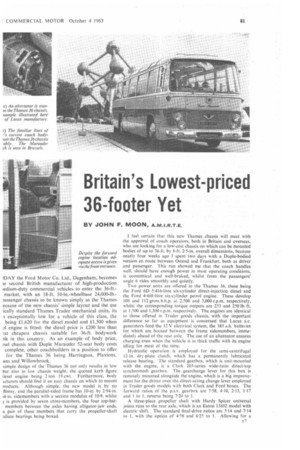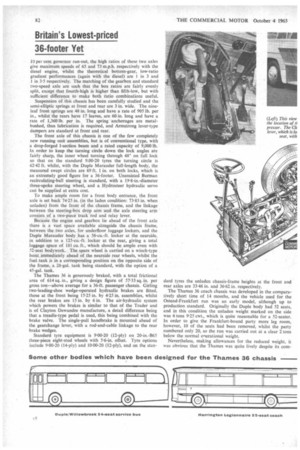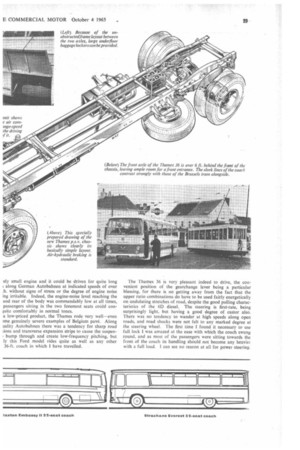Britain's Lowest-priced 36-footer Yet
Page 83

Page 84

Page 85

If you've noticed an error in this article please click here to report it so we can fix it.
BY JOHN F. MOON, A.M.1.R.T.E.
DAY the Ford Motor Co. Ltd., Dagenham, becomes le second British manufacturer of high-production ledium-duty commercial vehicles to enter the 36-ft.market, with an 18-ft. 10-In.-wheelbase 24,000-lb.mssenger chassis to be known simply as the Thames ecause of the new chassis' simple layout and the use ically standard Thames Trader mechanical units, its s exceptionally low for a vehicle of this class, the being £1,620 for the diesel model and £1,500 when J1 engine is fitted: the diesel price is £200 less than ;xt cheapest chassis suitable for 36-ft. bodywork )1e in this country. As an example of body price, seI chassis with Duple Marauder 52-seat body costs complete, other coachbuilders in a position to offer for the Thames 36 being Harrington, Plaxtons, ans and Willowbrook.
simple design of the Thames 36 not only results in low but also in low chassis weight, the quoted kerb figure liesel engine being 2 ton 19 cwt. Furthermore, body iicturers should find it an easy chassis on which to mount iroducts. Although simple, the new model is by no flimsy, and the parallel-sided frame has 10-in. by 2-94-in. i4-in. sidemembers with a section modulus of 10.9, whilst ; is provided by seven cross-members, the four top-hatmembers between the axles having alligator-jaw ends, e pair of these members that carry the propeller-shaft !diate bearings being boxed. 1 feel certain that this new Thames chassis will meet with the approval of coach operators, both in Britain and overseas, who are looking for a low-cost chassis on which can be mounted bodies of up to 36-ft. by 8-ft. 2.5-in. overall dimensions, because nearly four weeks ago 1 spent two days with a Duple-bodied version en route between Ostend and Frankfurt, both as driver and passenger. This. run showed me that the coach handles well, should have enough power in most operating conditions, is economical and well-braked, whilst from the passengers' angle it rides smoothly and quietly.
To power units are offered in the Thames 36, these being the Ford 6D 5-416-litre six-cylinder direct-injection diesel and the Ford 4.888-litre six-cylinder petrol engine. These dovelop 108 and 112 gross b.h.p. at 2,500 and 3.000 r.p.m. respectively, whilst the corresponding torque outputs are 253 and 250 lb. ft. at 1,500 and 1,300 r.p.m. respectively. The engines are identical to those offered in Trader goods chassis, with the important difference so far as equipment is concerned that Lucas a.c. generators feed the 12 V electrical system, the 185 a.h. batteries for which are housed between the frame sidemembers, immediately ahead of the rear axle. The use of an alternator ensures charging even when the vehicle is in thick traffic with its engine idling for most of the time.
Hydraulic operation is employed for the semi-centrifugal 12-in, dry-plate clutch, which has a permanently lubricated release bearing. The standard gearbox, which is unit-mounted with the engine, is a Clark 265-series wide-ratio direct-top synchromesh gearbox_ The gearchange lever for this box is remotely mounted alongside the engine, which is a big improvement for the driver over the direct-acting change lever employed in Trader goods models with both Clark and Ford boxes. The forward ratios of the p.s.v. gearbox arc 7-58, 4.10, 2.13, 1.17 and 1 to 1, reverse being 7-20 to 1.
A three-piece propeller shaft with Hardy Spicer universal joints runs to the rear axle, which is an Eaton 13802 model with electric shift. The standard final-drive ratios are 5.14 and 7-14 to 1. with the option of 4.50 and 6-25 to I. Allowing for a
10 per cent governor run-out, the high ratios of these two axles give maximum speeds of 65 and 73 m.p.h. respectively with the diesel engine, whilst the theoretical bottom-gear, low-ratio gradient performances (again with the diesel) are 1 in 3 and 1 in 3.5 respectively. The matching of the gearbox and standard two-speed axle are such that the box ratios are fairly evenly split, except that fourth-high is higher than fifth-low, but with sufficient difference to make both ratio combinations useful.
Suspension of this chassis has been carefully studied and the semi-elliptic springs at front and rear are 3 in. wide. The nineleaf front springs are 48 in. long and have a rate of 905 lb. per in., whilst the rears have 17 leaves, are 60 in. long and have a rate of 1,360 lb. per in. The spring anchorages are metalbushed, thus lubrication is required, and Armstrong lever-type dampers are standard at front and rear.
The front axle of this chassis is one of the few completely new running unit assemblies, but is of conventional type, with a drop-forged I-section beam and a rated capacity of 9,000 lb. In order to keep the turning circle down the lock angles are fairly sharp, the inner wheel turning through 48° on full lock so that on the standard 9.00-20 tyres the turning circle is 62.42 ft. whilst, with the Duple Marauder full-length body, the measured swept circles are 69 ft. 1 in. on both locks, which is an extremely good figure for a 36-footer. Unassisted Burman recirculating-ball steering is standard, with a 19.8-in.-diameter three-spoke steering wheel, and a Hydrosteer hydraulic servo can be supplied at extra cost.
To make ample room for a front body entrance, the front axle is set back 74/5 in. (in the laden condition: 73.83 in. when unladen) from the front of the chassis frame, and the linkage between the steering-box drop arm and the axle steering arm consists of a two-piece track rod and relay lever.
Because the engine and gearbox lie ahead of the front axle there is a vast space available alongside the chassis frame, between the two axles, for underfloor luggage lockers, and the Duple Marauder body has a 56-cu.-ft. locker at the nearside,• in addition to a 125-cu.-ft. locker at the rear, giving a total luggage space of 181 cu. ft., which should be ample even with 52-seat bodywork. The spare wheel is carried on a winch-type hoist immediately ahead of the nearside rear wheels, whilst the fuel tank is in a corresponding position on the opposite side of the frame, a 28-gal. tank being standard, with the option of a 45-gal. tank.
The Thames 36 is generously braked, with a total frictional area of 614 sq. in., giving a design figure. of 57.33 sq. in, per gross ton—above average for a 36-ft. passenger chassis. Girling two-leading-shoe wedge-operated hydraulic brakes are fitted, those at the front being 15.25 in. by 4.25 in. assemblies, whilst the rear brakes are 15 in. by 6 in. The air-hydraulic system which powers the brakes is similar to that of the Trader and is of Clayton Dewandre manufacture, a detail difference being that a treadle-type pedal is used, this being Combined with the brake valve. The single-pull handbrake is mounted ahead of the gearchange lever, with a rod-and-cable linkage to the rear brake wedges.
Standard tyre equipment is 9.00-20 (12-ply) on 20-in.-B65 three-piece eight-stud wheels with 5.6-in. offset. Tyre options include 9.00-20 (14-ply) and 10.00-20 (12-ply), and on the stan
dard tyres the unladen chassis-frame heights at the front and rear axles are 3346 in. and 36-62 in. respectively.
The Thames 36 coach chassis was developed in the comparatively short time of 14 months, and the vehicle used for the Ostend-Frankfurt run was an early model, although up to production standard. Originally the Duple body had 52 seats, and in this condition the unladen weight marked on the side was 6 tons 9-25 cwt., which is quite reasonable for a 52-seater. In order to give the Frankfurt-bound party more leg room, however, 10 of the seats had been removed, whilst the party numbered only 20, so the run was carried out at a clear 2 tons below the normal olerational weight.
Nevertheless, making allowances for the reduced weight, it was obvious that the Thames was quite lively despite its corn ely small engine and it could be driven for quite long ; along German Autobahnen at indicated speeds of over .h. without signs of stress or the degree of engine noise ing irritable. Indeed, the engine-noise level reaching the and rear of the body was commendably low at all times, passengers sitting in the two foremost seats could conluite comfortably in normal tones.
a low-priced product, the Thames rode very well—even me genuinely severe examples of Belgium pave. Along nifty Autobahnen there was a tendency for sharp road ions and transverse expansion strips to cause the suspen, bump through and create low-frequency pitching, but ly this Ford model rides quite as well as any other 36-ft. coach in which I have travelled. The Thames 36 is very pleasant indeed to drive, the convenient position of the gearchangc lever being a particular blessing, for there is no getting away from the fact that the upper ratio combinations do have to be used fairly energetically on undulating stretches of road, despite the good pulling characteristics of the 6D diesel. The steering is first-rate, being surprisingly light, but having a good degree of castor also. There was no tendency to wander at high speeds along open roads, and road shocks were not felt to any marked degree at the steering wheel. The first time I found it necessary to use full lock I was amazed at the ease with which the coach swung round, and as most of the passengers were sitting towards the front of the coach its handling should not become any heavier with a full load. I can see no reason at all for power steering_








































































































































































